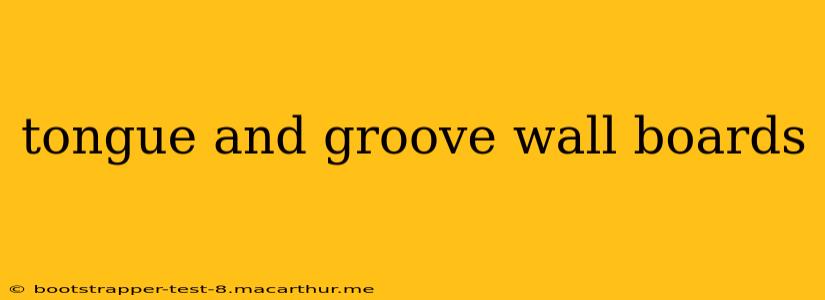Tongue and groove wall boards offer a classic and versatile solution for interior walls and ceilings, bringing a touch of rustic charm or clean sophistication depending on the chosen style. This comprehensive guide explores everything you need to know about tongue and groove wall boards, from installation to maintenance, ensuring you're well-equipped to make an informed decision.
What are Tongue and Groove Wall Boards?
Tongue and groove wall boards are boards milled with interlocking edges – a "tongue" on one edge and a "groove" on the other. This ingenious design allows for easy installation, creating a seamless and secure fit between each board. The tight connection minimizes gaps, enhancing insulation and providing a clean, aesthetically pleasing finish. The boards themselves are commonly made from wood, but you can also find them in engineered materials like MDF or even PVC for moisture-resistant applications.
Types of Tongue and Groove Wall Boards
The market offers a wide variety of tongue and groove wall boards, each with its unique characteristics:
- Wood: Traditional and popular, offering a natural aesthetic and warmth. Common wood types include pine, cedar, redwood, and oak, each imparting a distinct look and feel. Wood boards can vary in width, thickness, and length, influencing the overall appearance and structural integrity.
- MDF (Medium-Density Fiberboard): A more affordable alternative to solid wood, MDF tongue and groove boards offer a smooth, paintable surface. They are less durable than wood, however, and require careful handling during installation.
- PVC (Polyvinyl Chloride): Extremely durable and moisture-resistant, PVC tongue and groove boards are ideal for bathrooms, kitchens, and other areas prone to dampness. They come in a variety of colors and finishes, providing design flexibility.
- Engineered Wood: This encompasses various types that combine wood strands, veneers, or fibers with adhesives to create a stronger, more stable board than solid wood in some instances. Engineered wood options are available in different aesthetics, balancing cost and performance.
Advantages of Using Tongue and Groove Wall Boards
There are several compelling reasons to choose tongue and groove wall boards for your next project:
- Easy Installation: The interlocking system simplifies installation, making it a DIY-friendly option.
- Aesthetic Appeal: They provide a clean, finished look with a range of styles available to suit different aesthetics, from rustic to modern.
- Insulation: The tight fit between boards improves insulation, helping to regulate temperature and reduce noise.
- Durability: Depending on the material, tongue and groove boards can be highly durable and long-lasting.
- Versatility: They can be used in a variety of settings, both indoors and (with appropriate treatment) outdoors.
How to Install Tongue and Groove Wall Boards
Installing tongue and groove wall boards is a relatively straightforward process, but careful preparation is key. Generally, this involves:
- Preparation: Ensure walls are clean, level, and properly prepared.
- Framing: Install any necessary framing for support.
- Installation: Begin by attaching the first board, ensuring it's level and straight. Subsequent boards are simply inserted and tapped into place.
- Finishing: Trim excess boards as necessary and fill any gaps with appropriate filler.
What are the Different Types of Wood Used for Tongue and Groove Wall Cladding?
Many wood types are suitable for tongue and groove wall cladding. The choice depends on your budget, desired aesthetic, and the environment where they'll be installed. Popular options include pine (affordable and versatile), cedar (naturally resistant to rot and insects), redwood (durable and weather-resistant), and oak (strong and elegant). Each wood type offers a unique grain pattern and color, impacting the overall look.
How Much Does Tongue and Groove Wall Cladding Cost?
The cost of tongue and groove wall cladding varies greatly depending on the material, thickness, wood type (if applicable), and the overall project scope. Generally, engineered wood options or MDF will be cheaper than solid wood options like oak or redwood. Always factor in the cost of installation and any additional materials required.
Are Tongue and Groove Wall Boards Suitable for Bathrooms?
While traditional wood tongue and groove boards aren't ideal for bathrooms due to their susceptibility to moisture damage, moisture-resistant options like PVC or specially treated wood are suitable alternatives. Proper ventilation in the bathroom is crucial regardless of the material chosen.
How Do I Clean Tongue and Groove Wall Boards?
Cleaning methods depend on the material. Wood boards often benefit from a gentle wipe-down with a damp cloth. More stubborn stains may require specialized wood cleaners. For PVC or other non-wood materials, a simple damp cloth or a mild household cleaner is generally sufficient. Avoid abrasive cleaners that could scratch the surface.
Conclusion
Tongue and groove wall boards offer a timeless and elegant way to enhance your interior spaces. With careful planning and appropriate material selection, they provide a durable and aesthetically pleasing finish. Remember to choose the right material for your environment and budget, and enjoy the transformation this classic style can bring to your home.
